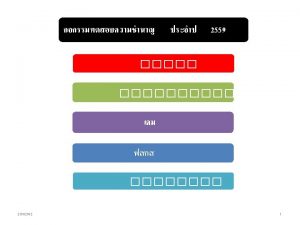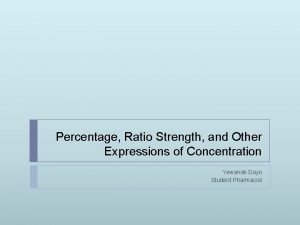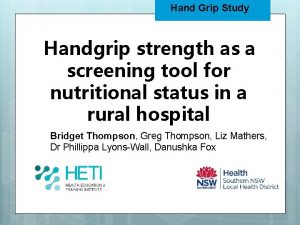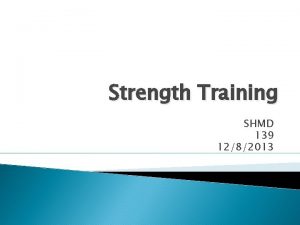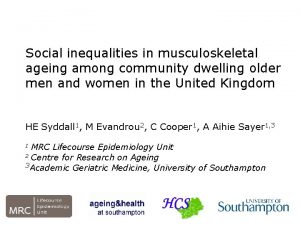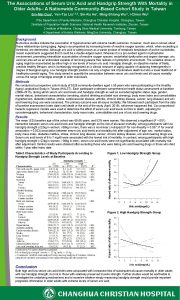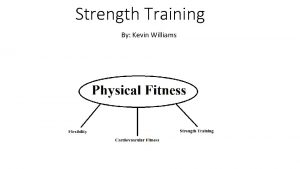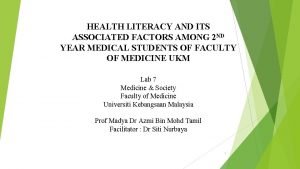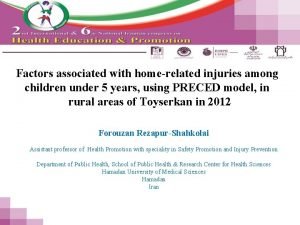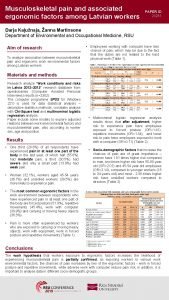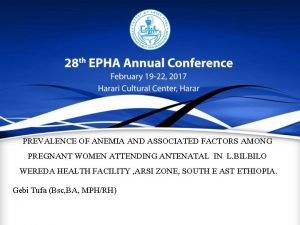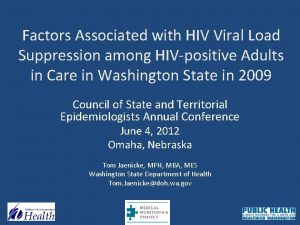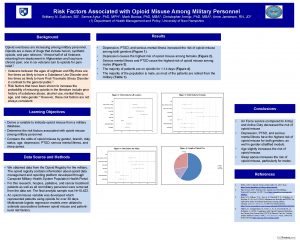Factors associated with handgrip strength among community dwelling

























- Slides: 25

Factors associated with handgrip strength among community dwelling elderly in Sri Lanka Ms. HDWT Damayanthi Prof. L. A. Khatijah Prof. F. M. Moy Prof. S. D. Darmarathne University of Malaya, Malaysia

Content • • Background & Introduction Objectives Methodology Results Discussion Conclusion Limitations References 2

Background & Introduction – Muscle strength declines with increasing age (Koopman et al. 2015) • Hand grip strength (HGS) -important to perform their daily life activities – holding objects – using a handrail or bus supports – carry out domestic tasks – self-care activities (Wagner et al. 2014)

Background & Introduction (ctd) • Handgrip strength -measure of maximum voluntary force of the hand (Moy et al. 2015) • Indicator – nutrition status – functionality – mortality • Risk-stratifying method • for all-cause death • cardiovascular disease

Background & Introduction (ctd) • A simple • Non-invasive • Reliable and low cost screening technique which does not require specialized professionals (Bohannon & Schaubert 2015) • Predictors – Depression – Physical activity – Demographic factors

Objectives • To examine the predictors of handgrip strength among an elderly population in Sri Lanka

Methodology • • • Cross sectional In Kandy district Sri Lanka From August to December, 2015 Multi-stage, cluster sampling was used N = 1200 Response rate 84. 6%

Methodology (ctd) • Ethical approval • Ethics committees of University Malaya Medical Centre, Malaysia & • Faculty of Allied Health Sciences, University of Peradeniya, Sri Lanka • An informed consent was obtained

Methodology (ctd) • Demographic data questionnaire • Handgrip strength- adjustable-handle Jamer dynamometer • Physical activity assessment – IPAQ • Depression assessment –GDS • Anthropometry – BMI – CC – MUAC

Methodology (ctd) Data analysis • IBM Statistical Program for Social Sciences (SPSS) version 21 • Complex sample analysis • Mean & CI -continuous variables

Methodology (ctd) • Complex samples univariate analyses -to assess race, marital status, medical conditions, smoking, alcohol, vegetarianism, BMI categories differences in handgrip strength • Complex samples general linear model analyses - to investigate associations between maximum handgrip strength and selected factors

Results • Female - 69. 3 • mean age of female - 70. 81 years (CI 69. 99 -71. 67) • mean age of males - 70. 78 years (CI 69. 64 -71. 93)

Handgrip Strength Beta coefficients (CI) P Male Vegetarian -1. 01(-3. 63, 1. 61) 0. 45 Alcohol consumption 2. 47 (-1. 59, 6. 53) 0. 23 Tooth loss -1. 16 (-4. 90, 2. 58) 0. 54 Use dentures 2. 90 (-0. 62, 6. 41) 0. 11 Age Weight Height MUAC CC BMI -0. 23 (-0. 44, -0. 02) 0. 10 (-0. 93, 1. 13) 15. 23 (-59. 94, 90. 41) 0. 50 (0. 10, 0. 90) 0. 16 (-0. 27, 0. 60) -0. 08 (-2. 61, 2. 45) 0. 03 0. 85 0. 69 0. 01 0. 45 0. 95 P<0. 05

Handgrip Strength Beta coefficients (CI) P Female Vegetarian -1. 27 (-2. 14, -0. 40) 0. 00 Alcohol consumption 4. 35 (3. 28, 5. 42) 0. 00 Age -0. 16 (-0. 22, -0. 09) 0. 00 Weight -0. 05 (-. 41, 0. 31) 0. 78 Height 8. 39 (-18. 94, 35. 71) 0. 55 MUAC 0. 17 (-0. 02, 0. 37) 0. 09 CC -0. 004 (-0. 19, 0. 18) 0. 97 BMI 0. 14 (-0. 59, 0. 88) 0. 70 Diabetes mellitus -2. 23 (-4. 14, -0. 32) 0. 02 P<0. 05

Discussion • Majority of the participants - female (74%) and more than 80% -married. • This may reflect the gender distribution among elderly of Kandy district • Males have greater hand grip strength than females which is in accord with many previous studies • Males are having greater muscle mass than females

Discussion(ctd) • Grip strength correlates - personal factors such as hand dominance • A recent systematic review -showed right dominant subjects had higher hand grip strength than left hand dominant subjects (Roberts et al. 2011) • Similar findings (Mitsionis et al. 2009)

Discussion(ctd) • Conversely, the left handgrip was higher than the right handgrip strength in both genders in the current study • The current study did not consider the non -dominant and dominant hands • Mean handgrip strength did not differ between right and left hands (Muzembo et al. 2014)

Discussion(ctd) • HGS -both genders declines with age • Decline of handgrip strength may represent an age-related change in physical function and frailty (Jang & Kim 2015)

Discussion(ctd) • Females- Alcohol consumption may have positive effects in HGS • It is contrast to the fact that alcohol affects changes in muscle protein degradation • High intake of alcohol increase serum uric acid which may have a protective role in aging-associated decline in muscle strength in community-dwelling elderly (Kawamoto et al. 2016)

Discussion(ctd) • Found negative association with diabetes mellitus among females • They might have affected by diabetic neuropathy (Park et al 2006) • Vegetarians- vegetarian diets are often low in protein • Mid upper arm circumference - significantly associated with HGS in both genders • HGS is directly proportional to muscle mass (Manoharan et al. 2015)

Conclusion • Comparatively lower handgrip strength than the western counterpart • HGS - different among genders • Age and mid upper arm circumference significantly predict handgrip strength among both males and females • Diabetes mellitus, vegetarian food habit and alcohol consumption are only found to be significant among females.

Limitations • A cross-sectional design - does not allow to comment on causality establish • Handgrip strength for left and right hands was measured rather than considering non -dominant and dominant hands

References • • Koopman, J. J. E. , van Bodegom, D. , van Heemst, D. , & Westendorp, R. G. J. (2015). Handgrip strength, ageing and mortality in rural Africa. Ageing, 44(3), 465 -470. Wagner, P. R. , Ascenço, S. , & Wibelinger, L. M. (2014). Hand grip strength in the elderly with upper limbs pain. Revista Dor, 15, 182 -185. Moy, F. M. , Darus, A. , & Hairi, N. N. (2015). Predictors of handgrip strength among adults of a rural community in Malaysia. Asia Pac J Public Health, 27(2), 176 -184. Bohannon, R. W. , & Schaubert, K. L. (2005). Test-retest reliability of gripstrength measures obtained over a 12 -week interval from communitydwelling elders. J Hand Ther, 18(4), 426 -427, quiz 428. Jang, J. Y. , & Kim, J. (2015). Association between handgrip strength and cognitive impairment in elderly Koreans: a population-based cross-sectional study. Journal of Physical Therapy Science, 27(12), 3911 -3915. Manoharan, V. S. Sundaram, G. S. Jason, J. I. (2015). Factors affecting hand grip strength and its evaluation: a systemic review. Int J Physiother Res, 3(6): 1288 - 1293. doi: 10. 16965/ijpr. 2015. 193

References (ctd) • • • Mitsionis, G. , Pakos, E. E. , Stafilas, K. S. , Paschos, N. , Papakostas, T. , & Beris, A. E. (2009). Normative data on hand grip strength in a Greek adult population. International Orthopaedics, 33(3), 713 -717 Muzembo, B. A. , Nagano, Y. , Eitoku, M. , Ngatu, N. R. , Matsui, T. , Bhatti, S. A. , . . . Suganuma, N. (2014). A cross-sectional assessment of oxidative DNA damage and muscle strength among elderly people living in the community. Environmental Health and Preventive Medicine, 19(1), 21 -29. Kawamoto, R. , Ninomiya, D. , Kasai, Y. , Kusunoki, T. , Ohtsuka, N. , Kumagi, T. , & Abe, M. (2016). Serum Uric Acid Is Positively Associated with Handgrip Strength among Japanese Community-Dwelling Elderly Women. PLo. S ONE, 11(4), e 0151044. Park, S. W. , Goodpaster, B. H. , Strotmeyer, E. S. , de Rekeneire, N. , Harris, T. B. , Schwartz, A. V. , . . . Newman, A. B. (2006). Decreased muscle strength and quality in older adults with type 2 diabetes: the health, aging, and body composition study. Diabetes, 55(6), 1813 -1818. doi: 10. 2337/db 05 -1183 Roberts, H. C. , Denison, H. J. , Martin, H. J. , Patel, H. P. , Syddall, H. , Cooper, C. , & Sayer, A. A. (2011). A review of the measurement of grip strength in clinical and epidemiological studies: towards a standardised approach. Ageing, 40(4), 423 -429.

Thank you
 John 1:14 among us
John 1:14 among us Yield and tensile strength
Yield and tensile strength Ratio strength to percent strength
Ratio strength to percent strength Darrow's solution composition
Darrow's solution composition What is the percentage strength of 1:1000
What is the percentage strength of 1:1000 Fastest land dwelling creature
Fastest land dwelling creature Dp-1 form
Dp-1 form Priestly golden head plate
Priestly golden head plate Mpdu homes for sale
Mpdu homes for sale Dwelling of the holy spirit
Dwelling of the holy spirit How lovely is your dwelling place verse
How lovely is your dwelling place verse Behold the dwelling place of god is with man
Behold the dwelling place of god is with man Lagellation
Lagellation Connotation for home
Connotation for home The student sitting next to you just came
The student sitting next to you just came Situation location
Situation location Biotic and abiotic components of an ecosystem
Biotic and abiotic components of an ecosystem Abiotic vs biotic factors
Abiotic vs biotic factors Aboitic environment
Aboitic environment Biotic and abiotic factors definition
Biotic and abiotic factors definition Site vs. situation
Site vs. situation Factors of 8 and 3
Factors of 8 and 3 Factors if 7
Factors if 7 Factos of 8
Factos of 8 Factors that affect location decisions
Factors that affect location decisions Prepare to scale up in community mobilization
Prepare to scale up in community mobilization

